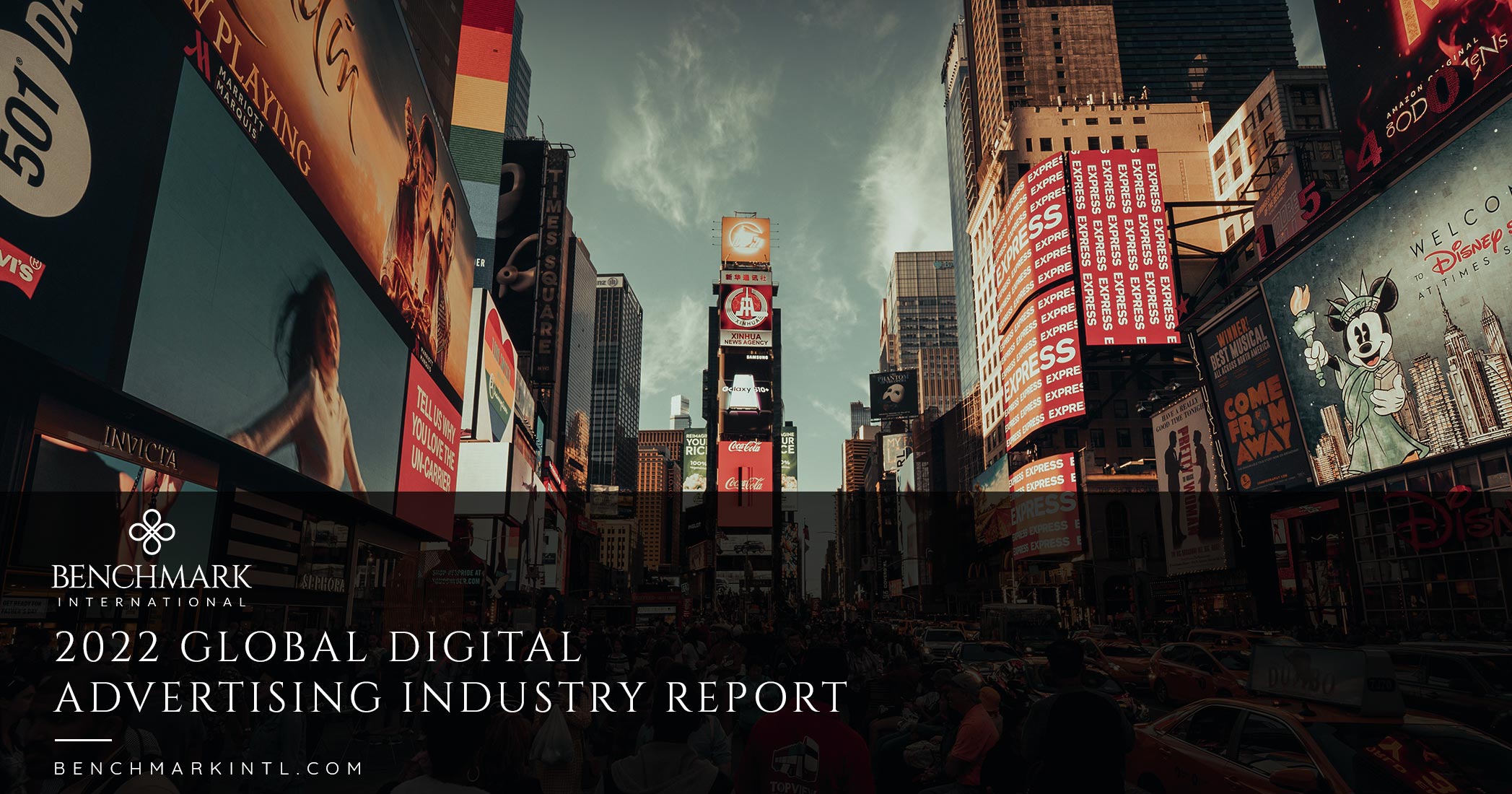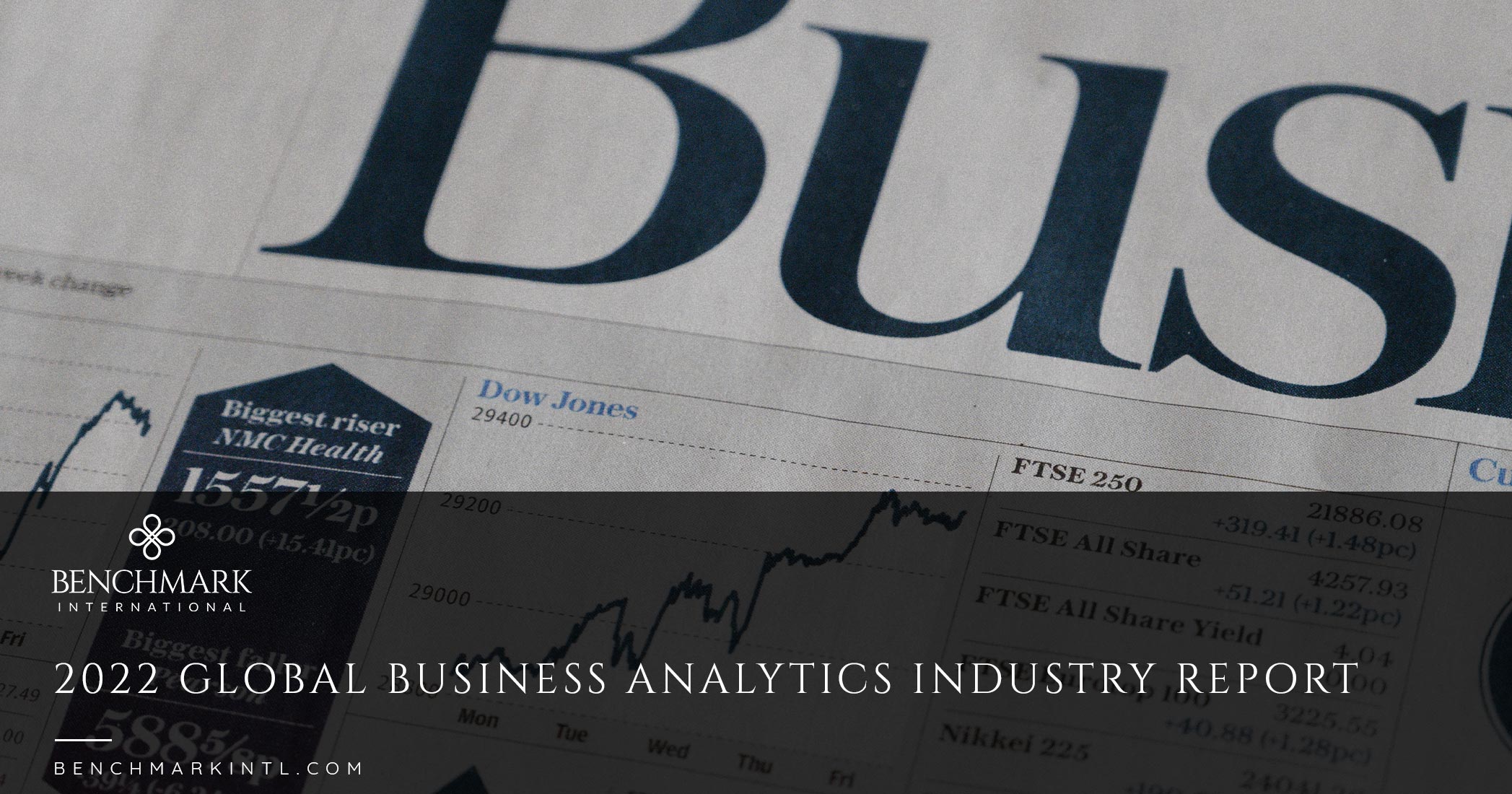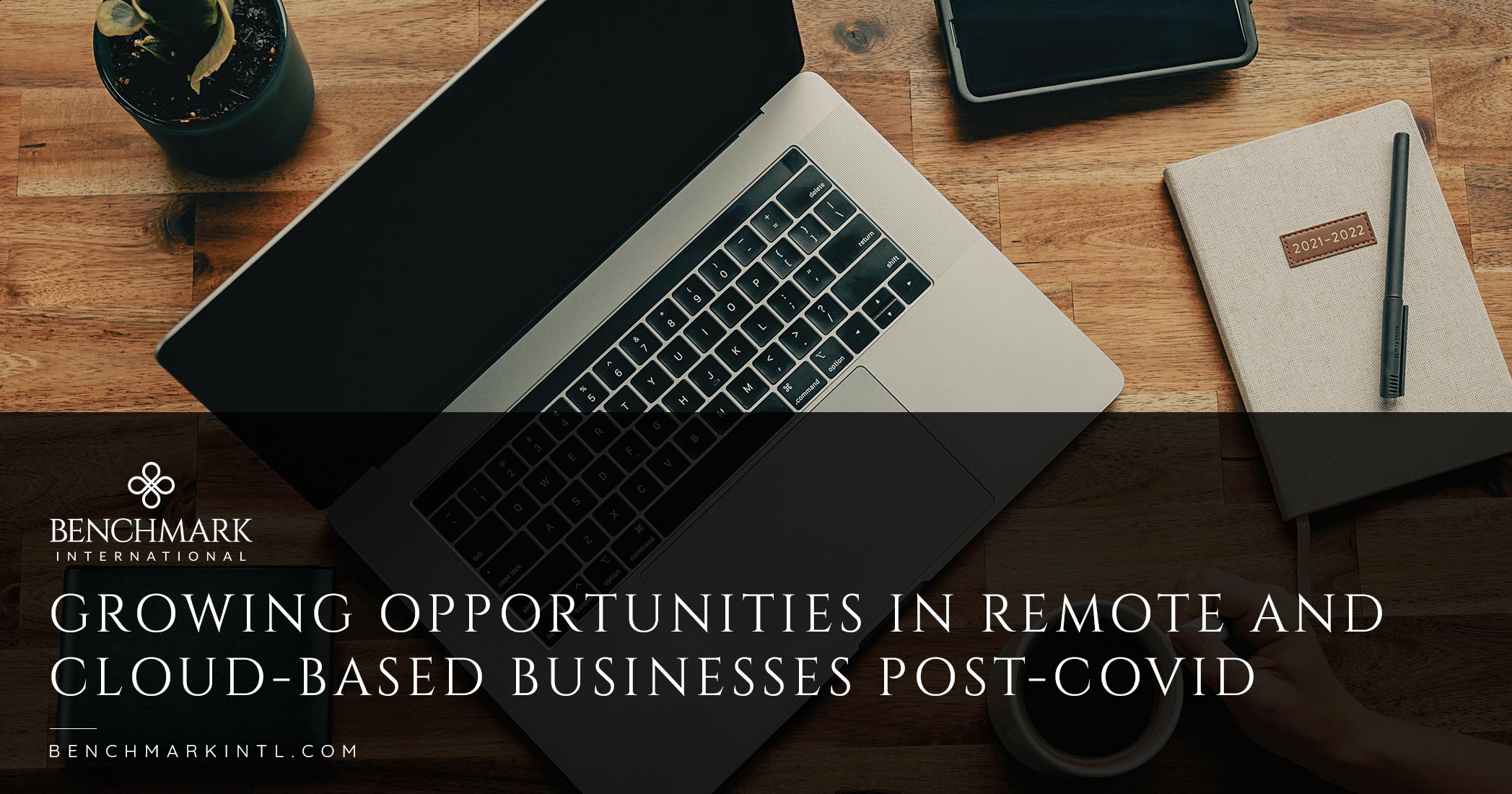The digital advertising sector is also often referred to as online marketing, Internet advertising, and web advertising. The market includes revenues gained by advertising activities conducted by organizations targeting consumers via Internet-enabled mobile devices and personal computers.
READ MORE >>Archives
2022 Global Digital Advertising Industry Report
Big Data & Cloud Storage Security Industry Report
Global Big Data Security Market
The global big data security market was valued at $24 billion in 2021 and is projected to reach $115 billion by 2030. That is a compound annual growth rate (CAGR) of 19% over the forecast period of 2022 to 2030. North America led the global market and is expected to grow at a CAGR of 17.5%.
READ MORE >>Share this:
2022 Global Business Analytics Industry Report
The global business analytics market was valued at $76.5 billion in 2021 and is forecast to reach $122.5 billion by 2027, growing at a compound annual growth rate (CAGR) of 8.1%.
READ MORE >>Share this:
2022 Industrial Robotics Industry Report
Industrial robotics is now critical across many sectors for the automation and manufacturing of many tasks, including loading, packaging, labeling, and inspection. They are commonly used in the automobile and heavy engineering sectors and are becoming more common in many other sectors. In the past, robots were mostly only used in the automotive and manufacturing industries, but more sectors are adopting them today. These sectors include defense, healthcare, aerospace, food & beverage, education, and electronics. There is also an increase in demand for telesurgery and elder care, as well as bomb dispersal, monitoring, and mine detection. There are currently around 2.7 million industrial robots in use worldwide, a number that is quickly rising.
READ MORE >>Share this:
2022 Global Space Industry Report
In 2021, the global space market was valued at $388.50 billion and is expected to reach $540.75 billion by 2026. The sector has expanded by an impressive 70% between 2010 and 2020. The space economy is expected to grow at a compound annual growth rate (CAGR) of 6.84% between 2022 and 2026. Analysts also predict that the space industry will reach $1 trillion in annual revenue by the year 2040, with launch costs lowered by 95%. As the cost of accessing space falls, opportunities for expansion and innovation will increase. The fastest growth is predicted to stem from new space applications and industries.
READ MORE >>Share this:
The Surge Of Cryptocurrency M&A
Deal activity continues to heat up in the cryptocurrency space as the adoption of crypto becomes more mainstream. Last year was a huge year for cryptocurrencies. In 2021, the price of bitcoin was up 49%, Ether was up 390%, and Dogecoin was up a whopping 1,600%. The M&A market for cryptocurrency soared by nearly 5,000% last year. But this is nothing compared to the activity for M&A of crypto companies.
READ MORE >>Share this:
Major Investment And M&A In The Metaverse
What Is the Metaverse?
The metaverse is an immersive digital online environment that links social and commercial activities through technologies such as virtual reality and augmented reality to create 3D virtual spaces that mimic reality. Its use is quite broad and can be applied to gaming, work meetings, e-commerce, socializing, or entertainment. The term “metaverse,” which was first introduced in the 1992 novel Snow Crash, is today considered a way to truly redefine the Internet. It is a concept that is still being shaped, but the vision is rapidly evolving. There is not necessarily one single defined metaverse, as various companies are working to shape the idea in their own ways. For example, blockchain tech such as cryptocurrency and non-fungible tokens (NFTs) are being used to support digital transactions in the metaverse. Video game makers are shifting their online worlds to resemble social networks with a market opportunity to expand to include live entertainment such as concerts and sporting events. With this transformation comes a battle for the share of social media ad revenue. And as the metaverse continues to evolve, it continues to represent a huge business opportunity.
READ MORE >>Share this:
2022 Sector Report: Esports Valued At Over A Billion Dollars
eSports is a form of video-game-based competition that has seen significant revenue and viewership growth in recent years. Much of the revenue is coming from advertising dollars from brands, such as ads shown during live streams on online platforms, video-on-demand content of matches, or on eSports TV. And competitive gaming is becoming more mainstream than ever.
READ MORE >>Share this:
2022 Fintech Industry Report
The global fintech market was valued at $6.5 trillion in 2021 and is estimated to grow at a compound annual growth rate (CAGR) of 13.9% between 2022 and 2028 to reach $16.65 trillion.
READ MORE >>Share this:
2022 Digital Healthcare Industry Report
Share this:
2022 Marketing Consulting, Branding & PR Industry Report
The Global Marketing Consulting Market
The global marketing consulting market is expected to grow by $3.83 billion between 2022 and 2026, increasing at a compound annual growth rate (CAGR) of 4.75%.
Market growth is being driven by various factors, including continued education, the rising need for improved customer digital experiences, and the providing of custom-made solutions.
Because the global marketing consulting market is rather fragmented, we are seeing vendors trying to remain competitive by deploying growth strategies such as forming strategic partnerships. Over the next four years, 35% of the global market’s growth will originate from North America.
READ MORE >>Share this:
Growing Opportunities In Remote And Cloud-based Businesses Post-covid
Digital tools have been advancing in business operations for years, but today they have become essential for most companies, especially since the onset of the COVID-19 pandemic. The global crisis forced businesses to find ways to connect their employees to each other and their customers without being in person. This storyline became so prevalent that, in the first year of the pandemic, 60% of businesses moved their workforces to the cloud. Two years later, this number continues to increase.
Such demand for rapid digitalization has become a key driver of M&A deals, and continues to create more opportunities for growth and transactions. As a result, many organizations are also adopting tools to facilitate the M&A process on more digital terms. These tools include data and analytics during due diligence, platforms that support fast-moving transactions, and cloud-based services. You can take a deeper dive into the facets of post-COVID due diligence here.
Share this:
Benchmark International Successfully Facilitated the Transaction Between Kaleidico, LLC and a Private Individual
The seller, Kaleidico, is made up of a team of experts that create and execute lead generation strategies for businesses in the mortgage lending and legal verticals. Their disciplined creative process has been generating leads since 2005.
READ MORE >>Share this:
Medtech M&A On Track For Strong Second Half Of 2021
In the first half of 2021, medtech M&A deals already surpassed the total number of deals from last year, and this bustle in activity is forecast to continue through the second half of the year, as medtech companies have stockpiled billions of dollars in cash. The dollar value of deals in 2021 is also expected to far outpace that of 2020. Eleven megadeals were announced in H1, with a total deal value of around $128 billion.
Medtech M&A activity kicked off 2021 right out of the gate, with at least 10 deals announced in January alone. Companies emerged from 2020 flush with cash reserves and were ready to spend on dealmaking. The medtech sector recorded a total of 33 deals in the first half of 2021. That's up from 25 total in all of 2020. In fact, the first quarter of 2021 was the busiest for medtech M&A since 2016. While the initial rapid momentum may have slowed, the second half of 2021 should be abundant with new deals.
READ MORE >>Share this:
How Do I Get The Most Out Of My SaaS Company?
As the owner of a Software as a Service (SaaS) company, there are several strategic steps you can implement in order to drive growth and maximize the value of your business.
1. Expand Geographically
READ MORE >>Share this:
Accelerating SaaS Growth With A Strategic Partner
Strategic partnerships can be game-changers for SaaS (Software as a Service) companies. Sales revenue is clearly of vital importance, but it takes more than just those numbers to make things happen on a larger scale. Relationships are the bedrock of business. If you are looking to drive growth, a strategic partnership can be a very powerful tool to help your company increase its audience, build upon the brand, and tap into new markets. All of this, in turn, can prop up your sales team and boost your overall growth.
READ MORE >>Share this:
Printing & Packaging M&A In 2020
In the printing and packaging sectors, M&A activity has slowed since August of 2019 with around 14 percent fewer deals closing. Deal activity was strong at the beginning of 2020, and then the COVID-19 pandemic brought everything to a standstill in the spring, with activity starting to return to normal in late summer. In fact, there were 16 transactions in August, which happens to be the same number as August of 2019.
The pandemic has made it more challenging to complete deals because of social distancing and how it impacts personal relationships, but buyers have not lost their strategic focus. The packaging side of the business has shown a heightened level of interest in labels, corrugated cartons, and folding cartons. Private equity and large corporate investors remain in the game. There is increased interest in flexible packaging, but the number of these transactions has been limited by the availability of target businesses in this segment.
READ MORE >>
Share this:
Life Sciences And Biotech M&A During Covid-19
The COVID-19 pandemic has created an urgent demand for testing, treatments and a vaccine from life sciences and biotech companies. It has also changed the deal-making landscape in this sector. Advances in genetic sequencing have led to the development of new immunotherapies and approaches to medicine that has lowered risk and boosted M&A value and volume.
Over the past five years, biotechnology M&A activity has generated hundreds of completed deals and hundreds of billions of dollars in aggregate value. Leveraged buyouts accounted for one fifth of all acquisitions completed in three of the past four years. The compound annual growth rate of the biotech market is 7.4 percent, on pace to reach $727.1 billion by 2025. There are currently upward of 100 experimental COVID-19 treatments and vaccines in development, including 11 being studied in clinical trials.
The life sciences sector is the key to a solution for COVID-19, from testing improvements to vaccine candidates. In April, Moderna Therapeutics was given $500 million from the U.S. Department of Health and Human Services to accelerate development of its mRNA vaccine. Over the past ten years, public and private sector researchers across biotech have collaborated to greatly reduce the lag time between genetic sequencing of a virus and running human trials. With academia partnering with governments to speed up development, it is expected to be positive for the long-term strength of the sector.
READ MORE >>Share this:
2020 Technology, Media And Telecom Sector Update
As the COVID-19 pandemic continues to impact everyday life, the technology, media and telecom sectors are playing critical roles in keeping people connected, working, and entertained. As more people work remotely and home school, the services provided by tech and telecom companies remain in peak demand by families and businesses.
- Acquisitions are driving growth in the tech sector, and there is more investment in innovation and R&D.
- Collaborative tech is expected to see sustained growth.
- As tech companies embrace working-from-home, talent is being spread out more geographically.
- Telecommunications companies are being relied upon for connectivity more than ever during the pandemic, and the focus on 5G-network implementation is a major priority.
- Broadcast TV faces challenges amid declines in advertising and fewer live sports, but ad revenue is expected to increase as many major sports are returning to play. Digital streaming and retransmission fees could also offer new opportunities.
- As video gaming and e-sports have undergone dramatic growth spurts during the pandemic, acquisition activity is expected to increase.
Share this:
2020 Global Outlook For The Marketing Sector
In a world of billions of connected smart devices, digital technology has essentially revolutionized the global marketing industry. From social media to content marketing, the market is massive and poised for continued growth.
The traditional ad agency model now includes a major focus on digital marketing, and digital marketing agencies continue to become more prevalent and provide a wider range of strategic services and specialized areas. And more and more companies outside of the advertising and marketing industry are also developing their own in-house digital marketing arms.
In 2019, the global digital marketing market size was $300-310 billion. It is expected to grow to $360-380 billion in 2020.
On a global scale, the market size per region is:
- $110-130 billion for North America
- $120-130 billion for Asia Pacific
- $48-52 billion for Europe
- $6-10 billion for the Middle East/Asia
Online videos and mobile ad spending account for a large portion of the digital advertising space and continue to drive digital marketing spending, especially in Europe and North America. Digital out-of-home media is becoming more personalized and contextually relevant through targeted ad delivery, and location-aware and bandwidth-aware tech tools. And with the increasing emergence of 5G technology in 2020, phone streaming will reach incredible speeds and higher quality, opening up new possibilities for marketers.
Content Marketing
2020 will be a big year for content marketing in several different forms. User-generated content will be in demand as the majority of consumers report that they find the opinion of users to be more influential than content promoted by the actual brand. This content includes anything from social media posts and blogs to web pages and testimonials.
Another huge component of content marketing is video content creation. More consumers are expecting to see video content from their favorite brands. Video also keeps audiences engaged for more time versus other types of content. Live streaming is also a growing trend, as consumers are reporting that they would prefer to watch live video than read a blog post.
Social Media
Marketers are forecasted to spend $112 billion on social media advertising in 2020.
Globally, North America continues to dominate ad spending in this digital marketing sector, with the retail industry as the leading ad spender in the United States. While search remains a preference of retail marketers, video, social media, and other display formats are growing in demand to increase brand visibility. Digital ad spending in the Asia Pacific region has surpassed that of Europe, with growth driven by China due to increasing investments on technology and digital platforms. The automobile, consumer goods, and telecom sectors are the leading marketing spenders in the country.
Digital marketing has had a large impact on the commercial print side of the industry. This is causing service providers to offer more innovative value-added services such as data management and e-publishing. The demand for print services is largely driven by the retail, financial, publishing, and food and beverage sectors, especially for on-demand print materials, packaging, and other promotional materials. Additionally, increased digitalization and eco-friendly practices (such as using soy ink vs. petroleum-based ink) have lessened the printing industry's impact on the environment. Increased digitization will continue to result in more e-versions of print, such as annual reports and catalogs, and use of more online targeting channels such as email.
Direct Mail
The size of the global direct mail market is expected to reach $94–98 billion in 2020. The use of direct mail remains high in developed regions such as North America and Europe due to comprehensive customer database maintenance. At the same time, the increased use of e-mail and mobile marketing is lessening the demand for printed direct mail materials. In smaller markets that have lower Internet penetration, such as parts of Latin America and the Middle East, the direct mail sector remains strong with demand being driven by retail, travel, and real estate. To remain competitive, direct mail providers are offering e-mail marketing and other digital marketing services at lower prices.
Loyalty Programs
The global market for loyalty programs continues to grow due to increasing e-commerce, smartphone use, and online shopping customer behavior. The retail, financial, consumer, and food and beverage industries drive the demand for loyalty services, digital rewards programs, analytics, and business intel used for customization.
Mergers & Acquisitions
M&A activity regarding digital marketing and advertising agencies has high potential due to growth and high fragmentation within the industry. Traditional ad agencies and private equity firms target companies that offer solid growth opportunities. As digital advertising revenues increase, so does the global demand for more online content in an ever-connected world. Digital capabilities and relationships are a priority for traditional agencies and their holding companies as they have a need to grow their digital revenue and expand their portfolios.
Thinking About Selling?
At Benchmark International, our award-winning team of M&A experts would love to hear from you and discuss how we can help you grow your business or sell your company for maximum value. Feel free to contact us at your convenience.
READ MORE >>Share this:
2020 Global IT Industry Outlook
The global Information Technology industry encompasses the sectors of hardware, software and services, telecom, and emerging tech including ‘as-a-service’ solutions under the umbrella of the Internet of Things (IoT) and automating technologies.
The global IT industry is projected to reach $5.2 trillion in 2020, with global spending growing 3.7%
As the world continues to be more digitally connected and industries become more automated, technology will remain a massively growing market in the beginning of the new decade, especially as companies focus less on cost reduction and more on innovation.
The United States is the world’s largest tech market, accounting for one-third of the total market, and exceeding the gross domestic product of most other industries. Although the US market is so large, the lion’s share of tech spending actually happens outside of the US (68%) and is made by enterprise or government entities. Western Europe is a major contributor in the global tech market, and China is also a significant player with focuses in robotics, infrastructure, software, and services.
Forecasted IT Spending
In 2020, IT spending budgets will be largely driven by the needs to upgrade outdated infrastructure, address security issues, and accommodate growth. The amount of spending and the mix of services will vary by company size.
- Smaller businesses are expected to spend more on hardware such as servers and laptops.
- Mid-size companies will be spending more on mobile devices.
- Larger corporations will spend more on managed infrastructure IT services such as power and climate solutions.
For software spending specifically, small businesses will focus their spending on operating systems. Mid-size companies will have a larger budget for productivity software and business support applications. Large enterprises will be spending more of their money on virtualization, database management, and communications software. Cloud services and recovery software will represent major budget allocations in the coming year and cloud spend will vary by company size.
Cloud Security
With the increasing popularity of cloud-based software and services and hybrid cloud solutions comes the increasing concern regarding cloud security. This is further reinforced by an ongoing rise in cyber attacks and data breaches. Cloud-based security solutions will remain a growing need across several sectors, especially in highly regulated ones such as finance and government. The global cloud security market was anticipated to garner $8.9 billion by the start of 2020. This need will create more opportunities for companies, entrepreneurs and investors.
The Year of 5G
The highly anticipated 5G technology will see a much more momentous rollout in 2020, in contrast to the lackluster emergence in 2019. Hundreds of millions of 5G-enabled smartphones are expected to ship in 2020. 5G will deliver significantly high speeds and remarkable data capacity to expand the financial possibilities for businesses. It is able to support billions of connected devices across sectors, allow new innovation for the IoT, Artificial Intelligence, and Virtual Reality. It will also enable a new world of autonomous vehicles and smart cities through a fully connected society, shattering boundaries to create a scalable global marketplace through unified technologies. Businesses will need to be prepared with how this new technology is going to dramatically alter the possibilities of the cloud and the need for virtualization-based networks as opposed to fixed-function equipment. While it is not going to happen overnight, 5G technology will grow increasingly more available throughout 2020, changing the availability of certain devices and transforming industrial possibilities.
Edge Computing
Edge computing is not a new concept, as it has existed for years. However, the value opportunity that it represents across industries is enormous. 2020 is anticipated to be a highly emergent year for edge computing due to the availability of faster networking technologies such as 5G and analytic capabilities in smaller devices.
Edge computing allows data processing to be done physically closer to where the data is generated (the edge of the network) rather than at a massive data processing center, which in turn reduces latency and processes the data much faster. This opens up countless new opportunities. Additionally, this technology offers several benefits for businesses, such as reduced costs, improved energy efficiencies, predictive maintenance, increased reliability, smart manufacturing, and security enhancements.
Let’s Talk Soon
At Benchmark International, our team of M&A advisors is ready to help you plan the next steps for you and your company. Whether it is selling your business, creating an exit strategy, seeking investor assistance, or finding ways to create growth, we are here to work on your terms to help you make your future as bright as possible.
READ MORE >>Share this:
M&A And The Big Data Industry
“Big data” has revolutionized the once traditional methods of analyzing data, making it possible to source more data at a much faster rate and with a great deal of variables. Companies that curate these massive databases do so to help businesses across all industries make more carefully calculated business decisions.
Big data sources revenue from software, hardware and professional services. It encompasses security, storage, infrastructure, networking, discovery tools, applications, and analytics, just to name a few.
The power of big data has grown with the widespread use of smartphones, social media and apps, and its technology continues to grow into edge environments, such as network nodes and industrial machines. Data is flowing between organizations of all sizes to help save time, save money, improve relationships, provide valuable insights, and advance technology. Big data is a major player in automation, artificial intelligence, cloud computing, and the Internet of things—innovations that are impacting virtually every industry in the world.
In an increasingly digitized society, everyone is looking to get a piece of the data pie. Technology companies are built on and around data. Advertising agencies look to acquire data companies in order to gain a competitive edge when it comes to understanding consumer behavior and targeting ads to audiences. Healthcare companies are spending billions on data companies to transform everything from precision medicine to medical records. In education, teaching and learning methodologies are being transformed by the use of big data. Mergers and acquisitions firms are using big data to improve target company searches and results. Essentially, there is no industry that is not somehow touched by the use of big data, and that results in sweeping opportunities for M&A transactions.
Big Data’s Impact on M&A
While individuals, companies and governments across many different business sectors are using big data more frequently, new techniques are making it possible to analyze big data more effectively. This can have a significant effect on certain areas of M&A, such as strategy, business model validation, and valuation.
- M&A strategies include value creation, operational synergies, risk arbitrage, and company turnaround. An M&A strategy is defined by the goals of the company, the skillsets of the M&A team members, and market factors that determine timing and viability. These factors are becoming more data driven in the making of strategic choices.
- Big data is greatly improving M&A target searches and screening processes. Better screening can lead to better matching of buyers and sellers, leading to a higher percentage of successful deal closings.
- Big data is making it possible to get a more detailed analysis of a company’s core business model regarding growth, market patterns, customer preferences, and market reaction to products.
- Combining big data with market-based valuation techniques will make it possible to extract multiples from much wider market databases. It will also make it faster and more reliable to compare a target company and the company’s valuation reference set.
Regulatory and Privacy Issues
While big data offers major benefits for companies of all industries—with benefits that are passed on to customers through a heightened understanding of their needs—there can be certain challenges when it comes to legal issues that concern privacy, government regulations, international access, and increased scrutiny of information collection practices.
A prime example of what big data must contend with is the changing privacy laws in Europe. In 2018, the European Union’s General Data Protection Regulation (GDPR)replaced an older law from 1995, creating a new regulation for privacy that affects organizations within the E.U., as well as organizations outside of the E.U. that offer goods and services to residents of the E.U. In addition to requiring clear privacy notices for users, the law also requires that organizations give 72-hours notice of a data breach. Users must also be given certain information about how their data will be used and are allowed to request deletion of their content.
The GDPR law is limited in that it only regulates data pertaining to individuals and not organizations, but it does have the potential to limit the type of data gathered. With such a rapidly growing industry that affects so many people and industries, it can be expected that other countries will take similar actions to regulate the use of big data, especially in the United States.
Contact Us
We do things differently. Please reach out to our M&A specialists at Benchmark International if you are thinking of selling a company in the middle and lower middle markets. We will formulate a partnership that works in your best interests, using our unique databases to thoroughly identify every possible option until we find the perfect solution for you and your business.
READ MORE >>Share this:
The Digital Marketing Industry and M&A
The trillion dollar advertising space is a rapidly changing industry with most of the action happening on the digital marketing side. As the world’s digital advertising revenues increase, there is a global demand for more online content. Lead generation, advertising, search engine optimization, and affiliate partnerships are major drivers of income in the 21st century marketing industry. This demand drives up the value of content-related businesses and digital marketing agencies in an era where everyone is glued to their connected devices. All of this screen time has caused traditional advertisers (print, TV, outdoor, radio) to shift their largest spends to digital marketing tactics and mobile internet advertising, even outspending television ads.
Worldwide digital advertising spending is predicted to reach $517 billion by the end of the year 2023.
The robust growth, sheer size, and high fragmentation of the digital marketing sector has led to healthy mergers and acquisitions activity involving digital agencies. Everyone from traditional advertising agencies to private equity investors is seeking target companies that offer growth benefits.
The establishment of digital capabilities and relationships has become a major priority for traditional ad agencies and their large holding companies as they look to grow their digital revenue and expand their portfolios. As conventional media continues to be displaced by digital marketing, the percentage of media spend on digital marketing on behalf of traditional ad agencies will continue to grow.
Evolving Technologies
In the digital marketing industry, there is also growing popularity of technologies that offer individualized features and more in-depth experiences. Brands are being pushed to invest and acquire these types of technologies while post-sales marketing has become a more prominent element along the customer journey.
- The use of chatbots and personalized messaging is enhancing customer experiences.
- Audio queries made possible by smart devices and digital assistants are driving voice search.
- Online video advertising is a quickly growing segment.
- Artificial intelligence analytics are helping to better target marketing strategies based off of real-time data. This data leads to meaningful insights that are used to improve customer interaction, and optimize media budgets and marketing strategies.
- Social search is changing e-commerce and vehicles for product reviews and recommendations.
This industry is sure to see more and more future technologies that have yet to be developed, continuing to drive rapid change and growth, and create opportunities for M&A.
Large User Platforms
Giant platform companies such as Google and Facebook provide free digital products and services but are still able to profit because they reach such massive audiences.
The larger the platform, the more consumer data is collected. The more a consumer uses the platform, the more information is gleaned about them. And with more data, the platform can better tailor the content consumers see, and keep them on the platform longer. This results in improved customer experiences and more advertising capacity, which means better understanding of consumers, heightened influence, and more revenue from targeted advertising.
Affiliate Partnerships
Affiliate partnerships use affiliate websites to promote products or services that belong to another company. The valuation of an affiliate website depends on the specific terms of the affiliate program. These factors include longevity, product category and seasonality, commission tiers, high caliber content, and the link portfolio. Websites that fulfill these attributes often have the better earnings, margins and lifecycle, which are attractive to investors. For valuation purposes, advertising agencies are similar to affiliate businesses because they are dependent upon content and end-user action to produce revenue.
These types of partnerships that monetize content also apply to offline businesses that need new and better ways to generate access to audiences. Investors also tend to be drawn to this segment based on existing relationships that can be used to an advantage.
Exit Opportunities
Some digital marketing agencies are being established with the goal of selling in mind. There are extremely low entry barriers when it comes to creating a digital marketing firm, but there are also limited benefits to growth. Some brands do not wish to work with a huge firm. And low employee tenure means lower retained corporate knowledge in an industry where talent retention is already incredibly challenging.
An agency with strong historical growth and projected growth of more than 20% can lead to strong multiples. The purchase of smaller agencies offers opportunities for growth for the large advertising agency groups and an easy way to cash out for the leadership of the smaller agencies.
Contact Us
Please feel free to contact our M&A advisors at Benchmark International to discuss your next move. Our industry expertise and global connections are true game changers when it comes to selling or growing a company, and forming an exit plan.
READ MORE >>Share this:
The Global Technology Industry and M&A
The trillion-dollar technology industry is inherently subject to massive growth, disruptive mega-trends, and voracious corporate and investor appetite. Companies such as Internet software and services, e-commerce, telecom, financial tech, cybersecurity, data analytics, social, travel tech, and auto tech are the world’s major players.
The main drivers for M&A in this sector are the creation of revenue growth, improved efficiencies, acquiring key talent, and staying ahead of competitors. It can be more efficient for a big tech firm to buy a smaller technology company in order to gain new functionality or services without creating them itself. It also serves as a pathway to ease into newer areas, as non-technology companies look to acquire technology companies to avoid disruption.
Mergers and acquisitions are commonly used as exit strategies for businesses in the technology industry. Company owners tend to prefer to cash in through M&A versus IPOs because IPOs can take longer and involve more regulatory authorities.
The Software Sector
Enterprise software and software as a service (SaaS) companies comprise a major segment of the technology industry. IT, data and cloud-based services have permeated every field of business in the world. Traditional and legacy software providers are using M&A in order to remain relevant. Healthcare, financial, and customer relationship management services software are continually in high demand. And digital marketing deals play a key part in the software M&A landscape.
Tech Company Valuations
Technology businesses that garner the highest company valuations for M&A typically share the same set of qualities:
- Reliable growth metric performance
- Good product/market fit
- Above-average margins
- Strong and predictable cash flows
- Positive key performance indicators
- Low owner involvement
- Streamlined operations
- A formulated exit plan
Additionally, investors are usually willing to pay more for businesses that have well-built brands because they are able to focus on long-term growth strategies without worrying about being eclipsed by intense competition while changes are being made.
Due Diligence
In the technology sector, careful due diligence is especially important to coordinating a successful deal. In an industry where lifecycles can be short and technologies can change quickly, there is great risk. Understanding the future relevance of the product or service is key. If a company is profitable today, it does not mean it will be tomorrow, making growth potential a larger motivating factor for M&A than current profitability. Therefore, in addition to financial due diligence, there needs to be a high level of technical and commercial due diligence. There are intellectual property issues, and due diligence must fully assess patents, copyrights, trademarks, domain names, trade secrets, and mask works
Cross-border M&A
Technology has completely blurred global borders, which greatly increases opportunities in M&A. While acquirers can expand their worldwide reach, this can also make the processes more complicated and time consuming for several reasons.
- Countries have varying and evolving regulations regarding technology and privacy, as well as tax and labor-related factors.
- Integration becomes more complex because of cultural differences, language barriers, and variances in corporate philosophies.
- The geographical distance between the companies can also make coordination difficult when trying to communicate in opposing time zones.
- Geopolitical factors can cause uncertainty and influence the feasibility of deals.
All of these circumstances change the implications for M&A strategies and calls for heightened expertise in dealing with cross-border transactions.
Contact Us
If you are considering a merger or an acquisition, you will love the way we do things at Benchmark International. We are motivated to achieve all of your aspirations and will never present you with a deal that we think will fall even the slightest bit short of your wants and needs. Count on our industry experts to use their global connections to deliver the right options for you.
READ MORE >>Share this:
Global Media Industry and M&A
Global media and entertainment conglomerates and their subsidiaries distribute mass media to the public such as television, gaming, radio, amusement parks, Internet, and publications. It’s in the nature of these types of companies—of all sizes—to continually pursue avenues for growth.
Over the years, we have seen just how much reinvention occurs in the global media industry. Consider how drastically the landscape has changed. In 1983, the media industry was dominated by 50 major companies. By 1987, that number was down to 29. In the early 1990s, the figure reduced to 23. By the end of the 1990s, there were only ten major conglomerates. In the 21stcentury, mega-deals starting taking place, causing the largest media groups to decrease in number but grow in size.
Key transaction areas for pursuing mergers and acquisitions in this global industry include:
- Horizontal-scale deals: Companies consolidate within their own sector to increasing earnings and improve operations.
- Cross-sector deals: Companies look outside their core sector to add products and services and integrate vertically across the supply chain.
- Cross-border deals: Companies target growth into different global markets that offer favorable long-term fundamentals.
- Portfolio optimizers: Companies use divestitures to streamline diversified asset bases and allocate capital to the most favorable opportunities.
Competition to Innovate
It is common in this sector for the attractive opportunities to draw a great deal of competition for acquisition. The landscape is rapidly and constantly evolving as new technologies emerge and key players are always seeking ways to be the one to introduce the next big thing. Streaming service and cord cutting have been the most recent significant drivers of change. Big tech firms such as Apple, Amazon and Netflix continue to ramp up the pressure on the conventional stand-alone media model, bringing content consumption to the forefront and making the need for differentiation and integration more critical to strategies for media companies.
Unique Due Diligence
In an industry where content is king, there are very specific due diligence challenges for M&A that require meticulous attention if the goals of the transaction are to be fully achieved.
- Copyright and Intellectual Property: Entertainment assets are subject to intellectual property protections that vary on regional, national and global levels, such as copyright, trademark and naming rights. Due diligence needs to dive deep into these rights, their usage and how they impact all parties involved, which can be extraordinarily complicated. The results of such a careful examination can directly affect valuation, so it must be conducted as thoroughly as possible.
- Large Volumes of Content:M&A transactions in the media and entertainment industry involve massive amounts of content that can be owned by a target company. There can be millions of individual items of content that could have been created decades ago and are now owned as a result of prior acquisitions. There should be prioritization of the most valuable content, especially if there are competing acquirers and a deal must be made quickly.
- Contractual Agreements:The production and distribution of entertainment content involves many different agreements and contractual arrangements. Careful due diligence will uncover key information regarding financial obligations, royalties, residuals and other contingent payments. How are royalty amounts determined and recouped? How do they compare with revenue and expenses in other financial documents? Does the transaction include agreements that expect the acquisition of more content in the future? Are there any unusual provisions or clauses regarding talent? These kinds of issues require solid understanding of how this industry operates.
Integration Challenges
Integration has been proven to pose a unique challenge for M&A in the media industry. One cannot simply plug and play a typical M&A process that works for other sectors. To win out, leadership needs to carefully evaluate the possibilities for value creation through integration, as well as any risks. This requires fastidious due diligence and effective communication. There must be a set of clearly defined goals. Cost and revenue synergies need to be properly valued. And retention of management is often critical to a successful integration strategy. When there is awareness of the potential integration pitfalls in media M&A deals, a plan can be formulated to help guard against them.
Contact Us
Are you planning on selling your company? Give us a call at Benchmark International to start the process. Our M&A experts can provide you with a comprehensive market analysis for your specific industry and arm you with exclusive information that will help you get your maximum value for your business.
READ MORE >>Share this:
Global Printing Industry Outlook
The global print market is shrinking in volume but growing in value. Output measured in billions of A4 prints was 49,973 back in 2014 but is forecast to decline very slightly to 49,654 by 2024. In value terms, print output is expected to grow from a total of $767.4 billion in 2014 to $862.7 billion in 2024 – a CAGR of 1.18%.
The role and dynamics of the print industry are changing, with the main factor being the impact of the internet and mobile connectivity on the way both businesses and individuals communicate and access information. This affects every segment of the traditional printing business, changing expectations of what is acceptable to speed, relevance, and degree of interactivity of data, irrespective of the medium used.
Share this:
M&A Trends in the Technology Sector – Why has it Reached New Highs?
A newly released report from Mergermarket concerning M&A trends in the first half of 2019 has shown that M&A in the technology sector has reached new highs. So far, 1,307 deals have been recorded in the technology sector this year, equating to 15.9% of deal activity by volume in 1H 2019, its highest half-yearly share on Mergermarket record.
In fact, in recent years tech M&A has reached record levels but what are the reasons for the industry’s popularity?
READ MORE >>Share this:
Here are the Reasons Why Private Equity Firms are Investing in SaaS Companies
There has been a steep incline in private equity investors buying SaaS (software as a service) companies over the last five years with PE firms investing in, recapitalising, and outright buying numerous SaaS companies. In fact, private equity accounted for 2.5% of all private equity portfolio acquisitions in 2018.
So, what are the reasons for private equity firms investing so heavily into SaaS companies?
READ MORE >>Share this:
UK Tech Start-Ups Likely to Grow Despite Brexit Uncertainty
Uncertainty and speculation are rife over Britain’s departure from the EU but, despite this, it has been a golden period for UK tech. With multi-billion pound exits and venture capital (VC) funding at record highs, it is unlikely that this will come to a halt – instead, there may be a shift in emphasis for the sector as a whole.
Technology start-ups can still thrive post-Brexit due to the reasons why they succeed – they need access to capital, access to talent and access to markets, and post-Brexit Britain should remain well positioned on all three.
READ MORE >> Benchmark International
Benchmark International  Benchmark International
Benchmark International 

































